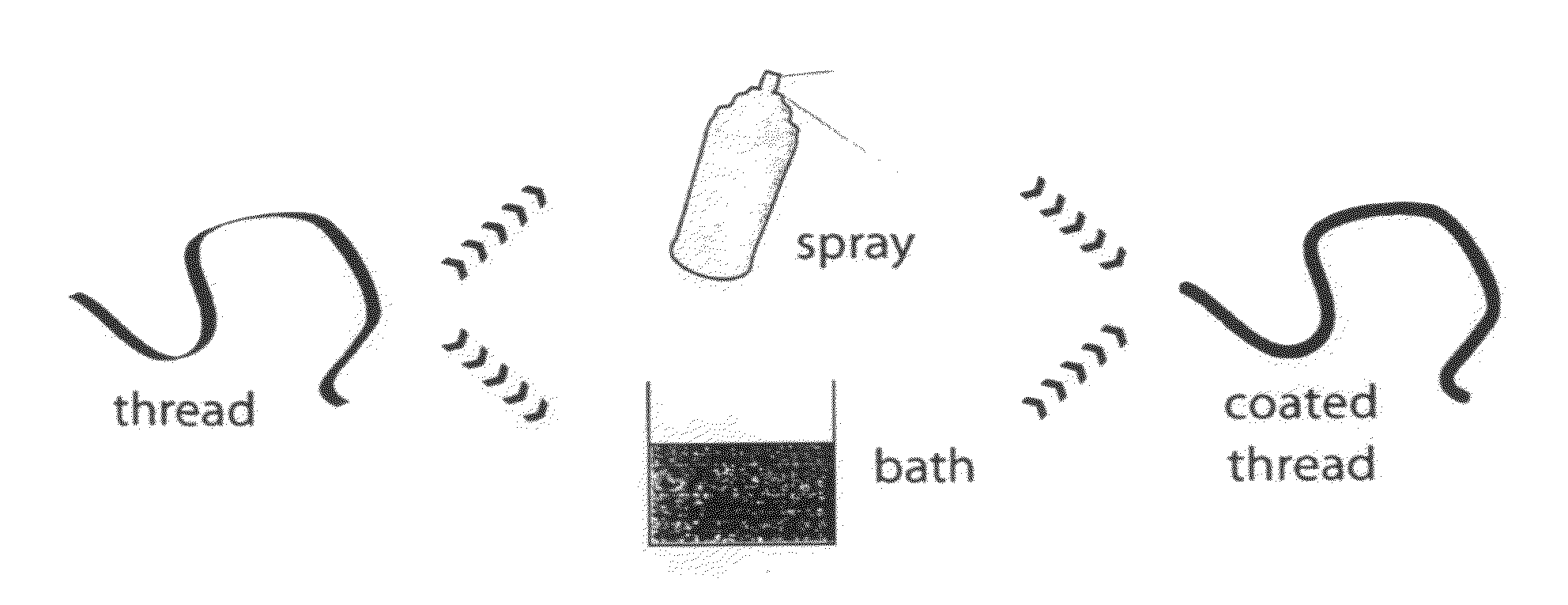Silk protein coatings
a technology of protein coating and coating, applied in the field of silk protein coating, can solve the problems of not being able to efficiently dye aramid threads, unable to attach molecules to the surface of aramid threads, and being easily wet,
- Summary
- Abstract
- Description
- Claims
- Application Information
AI Technical Summary
Benefits of technology
Problems solved by technology
Method used
Image
Examples
examples
[0266]In order to perform coating reactions, the inventors exemplarily designed the synthetic silk polypeptides C16, C32, C16NR4, (AQ)24 and (AQ)24NR3 which are derived from the dragline silk proteins ADF-3 and ADF-4 from the European garden cross spider Araneus diadematus. The proteins were chosen based on previous observations that ADF-3 and ADF-4 as well as their variants display an efficient assembly behaviour.
example i
Coating of an Aramid Fiber with the Spider Silk Polypeptide C16
[0267]A single aramid (Kevlar) fiber was incubated for 5 seconds in a HFIP (Hexafluoroisopropanol) solution containing 2 wt % / vol of the spider silk polypeptide C16 at room temperature (25° C.). After evaporation of the solvent, the spider silk polypeptide C16 formed a transparent film around the aramid fiber. The thickness of the film measured via electron microscopy was 3 μm (see FIG. 2).
[0268]The same results can be obtained with other solvents such as formic acid and water. Similar experiments were performed using nylon fibers, glass fibers, carbon fibers, cellulose fibers, PTFE (teflon) fibers, elastane (spndex) fibers and human hair. All examined fibers could be coated accordingly, using the described method.
[0269]To test the chemical stability of the coated fiber, spider silk polypeptide C16 coatings were incubated for 24 hours in 8 M urea, 6 M guanidinium hydrochloride and 6 M guanidinium thiocyanate. Spider s...
example ii
Covalent Coupling via Chemically Crosslinking of a Substance to the Silk Polypeptide C16 Coated on an Aramid Fiber
[0270]Many applications of fibers require the presence of specific functionalities on the fiber surface. In order to demonstrate that the spider silk coatings can be subsequently modified with a substance, the chromophor fluorescein and the enzyme β-galactosidase were chemically coupled to a silk polypeptide C16 coated on an aramid fiber as a proof of principle (see FIG.: 3). The coupling was achieved by activating surface exposed carboxyl groups of the spider silk polypeptide C16 using 1-ethyl-3-(3-dimethylaminopropyl)carbodiimide (EDC). The spider silk polypeptide C16 coated aramid fibers were further incubated with ethylenediamine leading to the formation of an amide. The remaining free amino group of ethylenediamine was subsequently coupled to fluoresceinisothiocyanate resulting in the efficient covalent linkage of fluorescein via formation of a stable thiourea deriv...
PUM
| Property | Measurement | Unit |
|---|---|---|
| thickness | aaaaa | aaaaa |
| thickness | aaaaa | aaaaa |
| thickness | aaaaa | aaaaa |
Abstract
Description
Claims
Application Information
 Login to View More
Login to View More - R&D
- Intellectual Property
- Life Sciences
- Materials
- Tech Scout
- Unparalleled Data Quality
- Higher Quality Content
- 60% Fewer Hallucinations
Browse by: Latest US Patents, China's latest patents, Technical Efficacy Thesaurus, Application Domain, Technology Topic, Popular Technical Reports.
© 2025 PatSnap. All rights reserved.Legal|Privacy policy|Modern Slavery Act Transparency Statement|Sitemap|About US| Contact US: help@patsnap.com



